| |
18 Million US Men Have Erectyle Dysfunction
|
| |
| |
"Prevalence and Risk Factors for Erectile Dysfunction in the US"
The American Journal of Medicine
February 2007
Elizabeth Selvin PhD, MPHa, b, , , Arthur L. Burnett MDc and Elizabeth A. Platz ScD, MPHa, c
aDepartment of Epidemiology, Johns Hopkins Bloomberg School of Public Health, Baltimore, Md
bWelch Center for Prevention, Epidemiology and Clinical Research, Johns Hopkins Bloomberg School of Public Health, Baltimore, Md
cJames Buchanan Brady Urological Institute, Johns Hopkins Hospital, Baltimore, Md
Abstract
Purpose: To assess the prevalence of erectile dysfunction and to quantify associations between putative risk factors and erectile dysfunction in the US adult male population.
Methods: Cross-sectional analysis of data from 2126 adult male participants in the 2001-2002 National Health and Nutrition Examination Survey (NHANES). Erectile dysfunction assessed by a single question during a self-paced, computer-assisted self-interview. These data are nationally representative of the noninstitutionalized adult male population in the US.
Results:
-- The overall prevalence of erectile dysfunction in men aged ≥20 years was 18.4% (95% confidence interval [CI], 16.2-20.7), suggesting that erectile dysfunction affects 18 million men (95% CI, 16-20) in the US.
-- The prevalence of erectile dysfunction was highly positively related to age but was also particularly high among men with one or more cardiovascular risk factors, men with hypertension, and men with a history of cardiovascular disease, even after age adjustment.
Among men with diabetes, the crude prevalence of erectile dysfunction was 51.3% (95% CI, 41.9-60.7).
In multivariable analyses, erectile dysfunction was significantly and independently associated with diabetes, lower attained education, and lack of physical activity.
Conclusions: The high prevalence of erectile dysfunction among men with diabetes and hypertension suggests that screening for erectile dysfunction in these patients may be warranted. Physical activity and other measures for the prevention of cardiovascular disease and diabetes may prevent decrease in erectile function
The recent development of effective oral pharmacological treatment has revolutionized the management of erectile dysfunction. The availability of effective oral therapy, changes to clinical guidelines making oral medication first-line treatment,1 and direct-to-consumer advertising have substantially increased awareness and treatment of this condition. The burden of this problem in the US is unclear, as previous prevalence estimates of erectile dysfunction have varied markedly depending on the population and survey instrument used. The epidemiology of erectile dysfunction has not been rigorously characterized in the general US population, although studies suggest links with atherosclerosis and cardiovascular disease.2, 3, 4 and 5 Erectile dysfunction can have a neurogenic, psychogenic, or endocrinologic basis, but the most common cause is thought to be related to vascular abnormalities of the penile blood supply and erectile tissue often associated with cardiovascular disease and its risk factors.
The present study was undertaken to assess the prevalence of erectile dysfunction in the general US male population overall and by age; to assess the prevalence of cardiovascular risk factors among individuals with erectile dysfunction; and to determine associations of cardiovascular risk factors, including lack of physical activity with prevalent erectile dysfunction. This studyfs prevalence estimates are nationally representative of the noninstitutionalized adult male population in the US.
Discussion
Approximately 18% or 18 million men in the US are estimated to have erectile dysfunction. Older men are particularly affected by this important quality of life problem. Our nationally representative data also provide further evidence that erectile dysfunction is related to cardiovascular disease. We observed significant and independent positive associations of cardiovascular risk factors and lack of physical activity with erectile dysfunction. The high prevalence of erectile dysfunction in men with hypertension and diabetes suggests that screening for erectile dysfunction among these patients may be warranted.
The association of diabetes with erectile dysfunction has been documented,1, 2, 3, 8, 9 and 10 and our data suggest that over half of all men in the US with diabetes are affected by erectile dysfunction. While the American Diabetes Association does not make specific recommendations about screening or treatment of erectile dysfunction among men with diabetes,11 clinicians should consider discussion of this common quality of life issue with their diabetic patients.
We observed a strong and graded association between self-reported measures of lack of physical activity level and erectile dysfunction prevalence. Although cross-sectional, these data support and expand on clinical trial data that suggest that lifestyle changes can improve male sexual function.12
Education, a measure of socioeconomic status, was strongly and independently associated with prevalent erectile dysfunction even after adjustment for other risk factors. Lower socioeconomic status has been shown to be a risk factor for cardiovascular disease,13, 14 and 15 but it is also possible that the reporting of erectile dysfunction differed by educational attainment level.
The attenuation of the age-adjusted associations of body mass index, benign prostate enlargement, and a history of cardiovascular disease with erectile dysfunction after multivariable adjustment for cardiovascular risk factors suggests that the association of these conditions on erectile dysfunction may be mediated in part by known cardiovascular risk factors such as hypertension, dyslipidemia, and diabetes.
The estimate for the association between current cigarette smoking and erectile dysfunction was not statistically significant after multivariable adjustment (OR = 1.60, 95% CI, 0.83-3.07), likely due to the cross-sectional nature of the survey. It is probable that individuals with prevalent erectile dysfunction may be more likely to have quit smoking compared to individuals without erectile dysfunction because current smoking is an established risk factor for the condition.16 This "quitting effect" may be particularly pronounced among men with one or more co-existing cardiovascular risk factors. Previous studies have shown strong prospective and independent associations between smoking and incident erectile dysfunction.2, 8, 17, 18 and 19
Our data update and expand on findings from the National Health and Social Life Survey (NHSLS), the Massachusetts Male Aging Study (MMAS), and the Health Professionals Follow-up Study (HPFS). The NHSLS, a cross-sectional face-to-face interview survey conducted in 1992 that included data on erectile dysfunction in 1243 men aged 18 to 59 years (response rate = about 79%), found that 8% of men (n = 97) reported "trouble maintaining or achieving an erection" and the prevalence of any form of "sexual dysfunction" in men was 31%.20 The MMAS, a study of approximately 1700 men in the Boston area surveyed in 1987-1989 (response rate = 53%, with 75% of those participants subsequently completing the sexual activity questionnaire), is usually cited as finding that the prevalence of erectile dysfunction was 52%. However, the MMAS definition of erectile dysfunction included men who were "usually able" to get and keep an erection in addition to men who were "sometimes" and "never" able, a more sensitive but less specific definition than the one used in our study. When applying to the MMAS data a definition comparable to the one we used, the prevalence of erectile dysfunction in the MMAS was 35% among men 40-70 years of age, still higher than our prevalence estimate in men aged 40-70 of 20.1% (95% CI, 17.2-23.0).8 The HPFS assessed sexual function via mailed questionnaire in 2000 (response rate for original survey = 32% with 79% of these participants completing the 2000 questionnaire) among over 30,000 men aged 53 to 90 years.21 Participants were asked to rate their ability in the previous 3 months, without treatment, to have and maintain an erection adequate for intercourse. Defining men who reported "poor" or "very poor" ability as having erectile dysfunction, the HPFS reported the prevalence was 32% in men aged over 50 years compared with 42.4% (95% CI, 38.6-46.2) in our study. Differing erectile dysfunction prevalence estimates from previous surveys are likely attributable to a combination of factors, including differences in study population, response rate (selection), method of erectile dysfunction assessment, and secular trends in social acceptability of discussion and awareness of erectile dysfunction.
The rigorous methodology used in NHANES provides nationally representative estimates of the prevalence of erectile dysfunction and its risk factors, and the relatively large sample size permitted us to examine erectile dysfunction prevalence within population sub-groups. This recent NHANES (2001-2002) was the first to collect information on erectile dysfunction. This survey was conducted before the introduction of other PDE5 inhibitors to the market in 2003, but widespread television and print advertising for sildenafil during this time may have contributed to increased awareness and the "medicalization" of this condition among US men, resulting in more accurate reporting of erectile dysfunction in this survey compared with previous studies. Nonetheless, several limitations of this study should be considered. Data on erectile dysfunction were self-reported, and some men may have currently been receiving treatment for the condition. Nonetheless, underreporting and lack of information on treatment would result in misclassification of cases as noncases in our study, biasing risk factor associations towards the null. Thus, the estimates presented here may actually underestimate the magnitude of the problem and associations in the US population. The cross-sectional nature of the NHANES limits conclusions about direction or causality of associations observed in this study but does provide direction for future etiologic research on erectile dysfunction.
With the advent of highly effective and widely available pharmacotherapy for erectile dysfunction, physicians should be aggressive in screening for and managing their middle-aged and older patients with this important quality-of-life issue. The association between erectile dysfunction and lack of physical activity suggests that lifestyle changes, especially increasing exercise level, may be effective nonpharmacological treatments. The associations between erectile dysfunction and diabetes, and other known cardiovascular risk factors should serve as powerful motivators for male patients for whom diet and lifestyle changes are needed to improve their cardiovascular risk profile. These data suggest physical activity and other measures for the prevention of cardiovascular disease and diabetes may prevent decline in erectile function.
Methods
Study Population
This study was based on data from the 2001-2002 National Health and Nutrition Examination Survey (NHANES), an ongoing cross-sectional survey of the civilian, noninstitutionalized population of the US. Detailed in-person interviews, physical examinations, and serum samples were obtained from over 10,000 persons. The study population here was limited to those men over 20 years of age who were not missing data on erectile dysfunction. The mobile examination center overall response rate for the 1999-2002 survey was 78.1%. The response rate for the erectile dysfunction question was 91%.
The eligible study sample consisted of 2126 men aged 20 years and older with valid data on erectile dysfunction. For the purposes of this study, multivariable analyses of cardiovascular risk factors were further limited to men 40 years and older (n = 1427) to minimize residual confounding by age. Men with a history of prostate cancer (n = 68) also were excluded from the analyses of cardiovascular risk factors, as surgical, radiation, and hormonal therapies for this cancer are known to contribute to erectile dysfunction.
Assessment of Erectile Dysfunction
Erectile dysfunction was assessed in the Prostate Conditions Section of the examination interview administered to men aged 20 years and older. This portion of the survey was conducted in a private room using a self-spaced audio computer-assisted self-interview system that enabled respondents to both hear questions through earphones and read questions on the computer.
Erectile dysfunction was assessed using the following question: "Many men experience problems with sexual intercourse. How would you describe your ability to get and keep an erection adequate for satisfactory intercourse? Would you say that you are c always able or almost always able to get and keep an erection, usually able to get and keep an erection, sometimes able to get and keep an erection, or never able to get and keep an erection?" The validity of this single-question self-assessment for erectile dysfunction has been shown previously.6
For the purposes of this study, "erectile dysfunction" was defined as "sometimes able" or "never able" to get and keep an erection. Men who reported being "always or almost always able" or "usually able" to get and keep an erection were categorized as not having erectile dysfunction.
Assessment of Demographics and Cardiovascular Risk Factors
The NHANES examination included measurement of height, weight, blood pressure, and collection of blood sample by trained personnel. Hypertension was defined as a mean systolic blood pressure of ≥140 mm Hg, a mean diastolic blood pressure of ≥90 mm Hg, or reporting a physician diagnosis of high blood pressure. Mean blood pressure was comprised of up to 4 readings on 2 separate occasions. Hypertensive individuals who reported taking a current prescription medication for hypertension were categorized as having treated hypertension. Total cholesterol was measured enzymatically.7 Hypercholesterolemia was defined as a total cholesterol level 240 mg/dL or higher, self-report of a physician diagnosis of "high cholesterol", or self-report that a physician had advised taking a cholesterol-lowering medication. Diabetes was defined as self-reported physician diagnosis, use of diabetes medication, an 8-hour fasting glucose ≥126 mg/dL, or a nonfasting glucose ≥200 mg/dL.
Information on age, sex, race/ethnicity, marital status, and smoking was based on self-report during the questionnaire portion of the survey. Prevalent cardiovascular disease was defined as a self-reported history of coronary heart disease, previous heart attack, or history of stroke. Benign prostate enlargement was defined according to self-reported history obtained during the Prostate Conditions portion of the survey. Prostate cancer history was self-reported and determined from information from the Prostate Conditions and Medical History Sections of the survey.
Information on physical activity was self-reported during the in-person home interview. The summary measure of physical activity of interest here was based on responses to questions about whether the participant engaged in moderate or vigorous activity over the past 30 days. We also examined associations with a measure of sedentary behavior (daily hours of TV, computer, and video use), muscle-strengthening activities, walking and bicycle riding habits, and participantsf comparison of their activity level to others of same age. See the Appendix for the full text of questions.
Detailed information about data collection in NHANES is available elsewhere.7
Statistical Analysis
The NHANES surveys are ongoing complex, multi-stage probability samples of the civilian, noninstitutionalized population of the U.S. Analyses were performed using Stata Version 8.2 (StataCorp, College Station, Tex) svy commands to obtain unbiased estimates from the complex NHANES sampling design. Standard errors for all estimates were obtained using the Taylor series (linearization) method.7 We calculated crude and age-adjusted prevalence estimates of erectile dysfunction by demographic and cardiovascular risk factors and the prevalence of cardiovascular risk factors by the presence of erectile dysfunction. Adjusted odds ratios and their 95% confidence intervals (CI) were estimated using logistic regression models. "Model 1" included a term for age only, while "Model 2" included terms for age, race/ethnicity, marital status, education, smoking, body mass index, hypertension, hypercholesterolemia, and diabetes.
Results
The overall prevalence of erectile dysfunction in the general US male population aged 20 years and older was 18.4% (95% CI, 16.2, 20.7) (Table 1). Applying this value to 2000 Census estimates for men aged 20 and older suggests that there are 18 million men (95%CI, 16, 20) in the US with erectile dysfunction (Figure). The prevalence of erectile dysfunction differed markedly by age, ranging from 5.1% (95% CI, 3.8-6.4) in men aged 20-39 years to 70.2% (95% CI, 65.6-74.9) in men aged 70 years and older. When broken down according to the specific categories of erectile function, 65.0% (95% CI, 61.9-68.1) of men reported being "always or almost always able" to get and keep an erection, 16.5% (95% CI, 14.8-18.2) reported being "usually able," 12.3% (95% CI, 10.9-13.6) reported being "sometimes" able, and 6.2% (95% CI, 4.8-7.6) reported being "never" able.
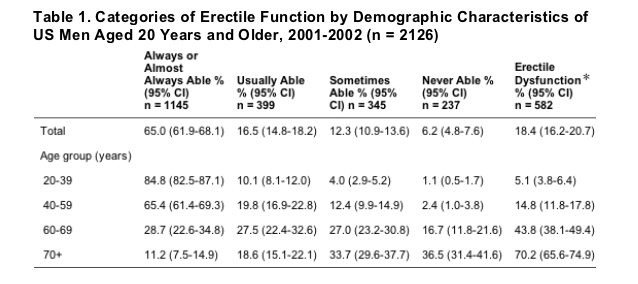
Erectile function was assessed using the question: How would you describe your ability to get and keep an erection adequate for satisfactory intercourse? Answers were categorized as "always or almost always able," "usually able," "sometimes able," or "never able." Erectile dysfunction was defined as "sometimes" or "never" able to attain an erection adequate for satisfactory sexual intercourse.
Table 2 presents the crude and age-adjusted prevalence of erectile dysfunction by cardiovascular factors and prostate disease in the population of men aged 20 years and older. The crude prevalence of erectile dysfunction was 50% in individuals with diabetes (51.3%, 95% CI, 41.9-60.7) or a history of cardiovascular disease (50.0%, 95% CI, 41.7-58.3). The crude prevalence of erectile dysfunction was 13.1% (95% CI, 10.7-15.4) among current smokers and 21.8% (95% CI, 16.6-27.1) among obese individuals (body mass index >30 kg/m2). Slightly less than half of all individuals with treated hypertension (44.1%, 95% CI, 37.2-51.1) or a self-reported history of benign prostate enlargement (42.6%, 95% CI, 33.3-51.9) were affected by erectile dysfunction. Comparing the crude and age-adjustment estimates suggests that age is an important confounder, but the prevalence of erectile dysfunction among persons with cardiovascular risk factors such as hypertension, diabetes, and a history of cardiovascular disease remained high even after adjustment for age.
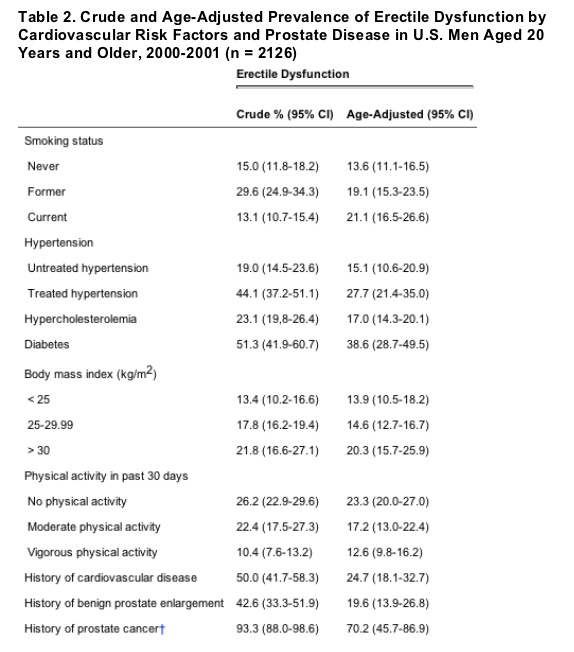
Table 3 shows that men with erectile dysfunction were an average of 10 years older than men without erectile dysfunction. Thus, all prevalence estimates for cardiovascular risk factors among men ≥40 years with and without erectile dysfunction in Table 3 were age adjusted. Even after age adjustment, men with prevalent erectile dysfunction had a much higher prevalence of cardiovascular risk factors and existing cardiovascular disease compared to men without erectile dysfunction. The age-adjusted prevalence of diabetes was 30.9% (95% CI, 21.9-41.6) among men with erectile dysfunction compared with only 9.4% (95% CI, 7.1-12.4) in men without erectile dysfunction. Men with erectile dysfunction were less likely to report having engaged in vigorous physical activity in the past 30 days: 28.0% (17.8-38.1) compared with 39.1% (33.3-44.8) in men without erectile dysfunction. Almost about 90% (95% CI, 81.4-92.5) of men with erectile dysfunction had at least one major cardiovascular disease risk factor (hypertension, hypercholesterolemia, current smoking, or diabetes).
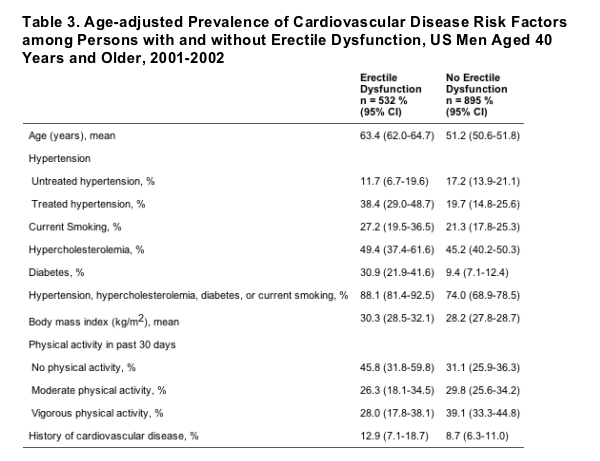
Table 4 displays the age- and multivariable-adjusted odds ratios (OR) for prevalent erectile dysfunction by cardiovascular risk factors in men aged 40 years and older. Even after multivariable adjustment (Model 2), diabetes (OR = 2.91, 95% CI, 1.47-5.73) and having less than a high school education (OR = 2.14, 95% CI, 1.38-3.12) were significantly associated with erectile dysfunction. Current smoking status was significantly associated with erectile dysfunction in the age-adjusted model (Model 1), but this association was slightly attenuated after adjustment for cardiovascular risk factors (OR = 1.60, 95% CI, 0.83-3.07). Body mass index >30 kg/m2 was similarly significantly associated with erectile dysfunction in the age-adjusted model (Model 1), but the association was attenuated after adjustment for cardiovascular risk factors (OR = 1.48, 95% CI, 0.89-2.45). A self-reported history of benign prostate enlargement was borderline significantly associated with erectile dysfunction after multivariable adjustment (OR = 1.64, 95% CI, 0.98-2.73).
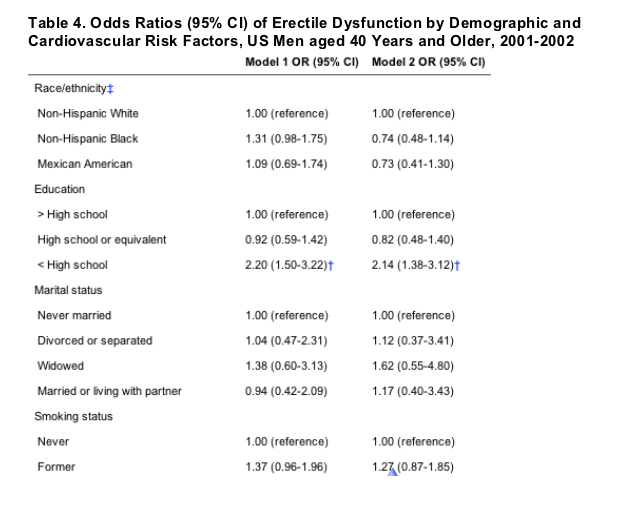
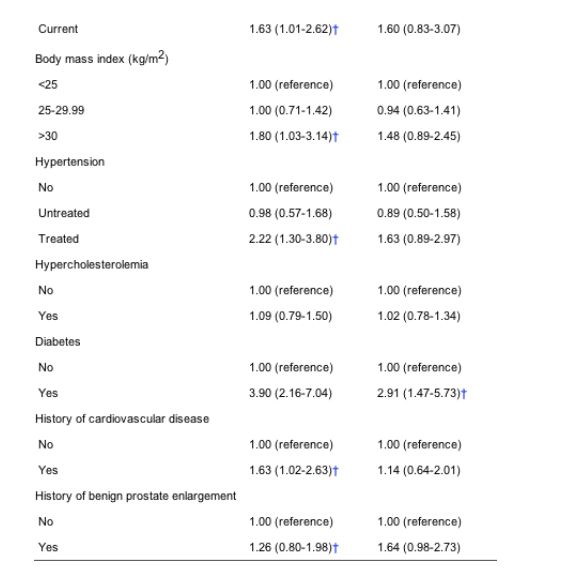
Table 5 presents the adjusted ORs for prevalent erectile dysfunction by selected measures of physical activity and sedentary behavior. Even after multivariable adjustment, high levels of sedentary behavior-as measured by reported daily hours of TV/video/computer use-were strongly associated with an increased likelihood of prevalent erectile dysfunction (OR = 2.94, 95% CI, 1.56-5.44 for 5+ hours of daily use compared with <1 hour). Additionally, when participants were asked to compare their activity level to others of the same age, men who reported that they were "less active" were more likely to have erectile dysfunction (OR = 2.73, 95% CI, 1.37-5.39).
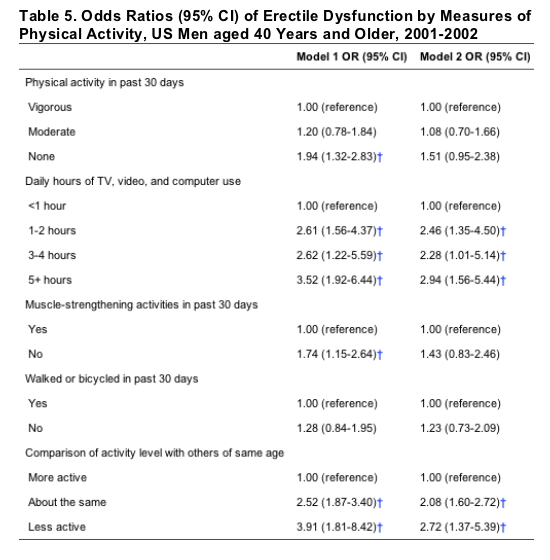
|
|
| |
| |
|
|
|